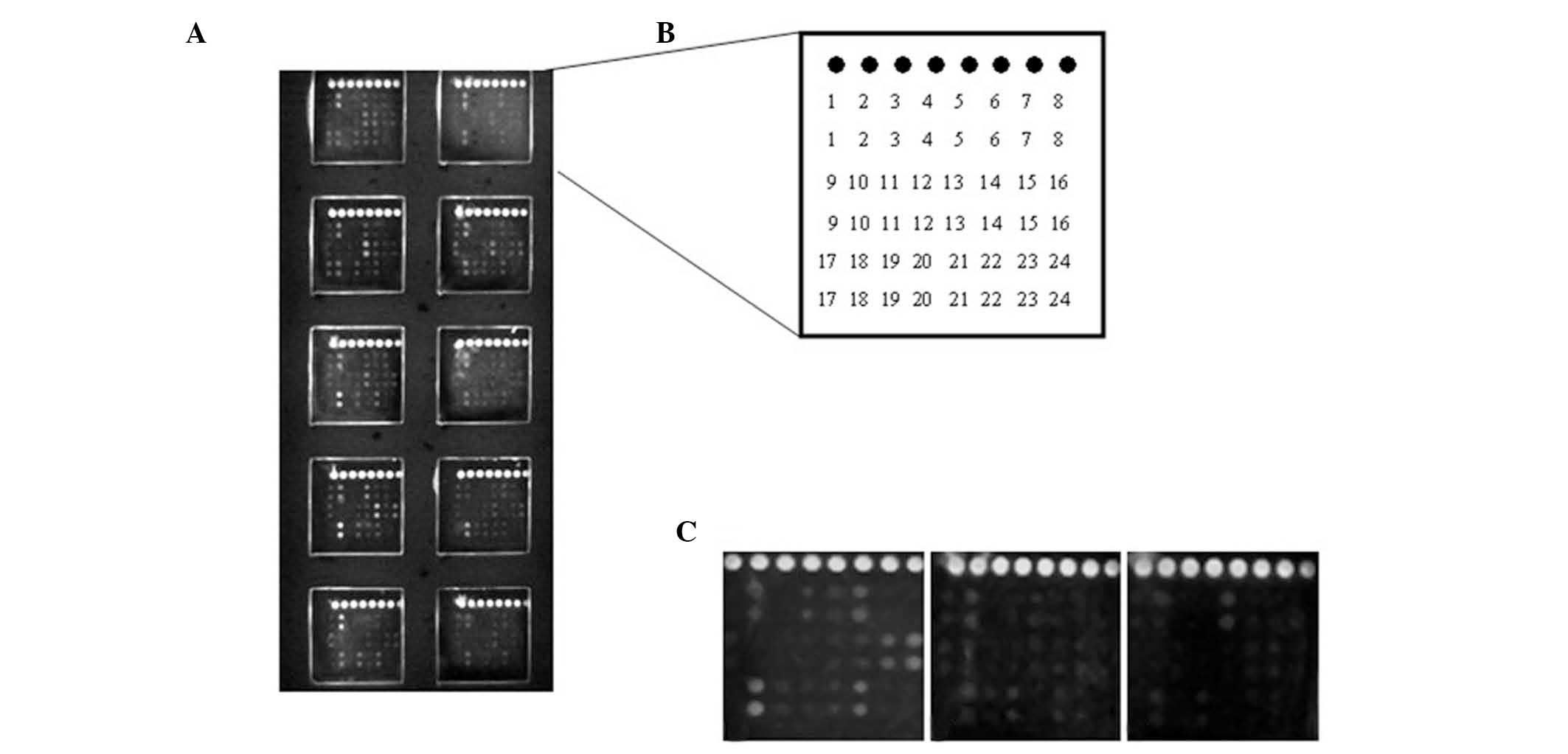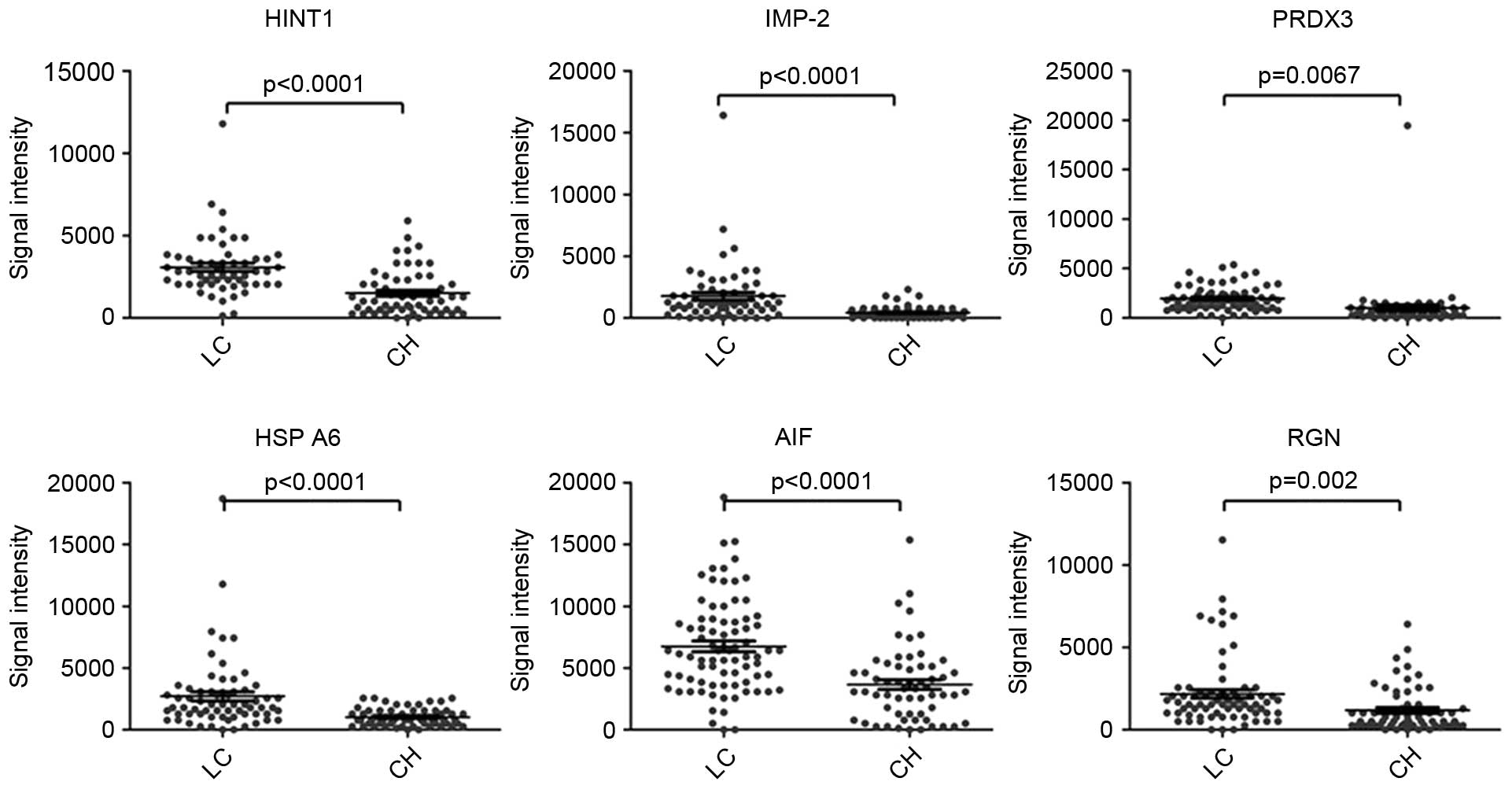|
1
|
European Association For The Study Of The
Liver, . EASL Clinical Practice Guidelines: Management of chronic
hepatitis B. J Hepatol. 50:227–242. 2009. View Article : Google Scholar : PubMed/NCBI
|
|
2
|
Bini EJ and Perumalswami PV: Hepatitis B
virus infection among American patients with chronic hepatitis C
virus infection: Prevalence, racial/ethnic differences, and viral
interactions. Hepatology. 51:759–766. 2010.PubMed/NCBI
|
|
3
|
Tan HT, Low J, Lim SG and Chung MC: Serum
autoantibodies as biomarkers for early cancer detection. FEBS J.
276:6880–6904. 2009. View Article : Google Scholar : PubMed/NCBI
|
|
4
|
Xu YW, Peng YH, Chen B, Wu ZY, Wu JY, Shen
JH, Zheng CP, Wang SH, Guo HP, Li EM and Xu LY: Autoantibodies as
potential biomarkers for the early detection of esophageal squamous
cell carcinoma. Am J Gastroenterol. 109:36–45. 2014. View Article : Google Scholar : PubMed/NCBI
|
|
5
|
Werner S, Chen H, Tao S and Brenner H:
Systematic review: Serum autoantibodies in the early detection of
gastric cancer. Int J Cancer. 136:2243–2252. 2015. View Article : Google Scholar : PubMed/NCBI
|
|
6
|
Peng B, Huang X, Nakayasu ES, Petersen JR,
Qiu S, Almeida IC and Zhang JY: Using immunoproteomics to identify
alpha-enolase as an autoantigen in liver fibrosis. J Proteome Res.
12:1789–1796. 2013. View Article : Google Scholar : PubMed/NCBI
|
|
7
|
Lacombe J, Mangé A and Solassol J: Use of
autoantibodies to detect the onset of breast cancer. J Immunol Re.
2014:5749812014.
|
|
8
|
Hong Y, Long J, Li H, Chen S, Liu Q, Zhang
B, He X, Wang Y, Li H, Li Y, et al: An analysis of immunoreactive
signatures in early stage hepatocellular carcinoma. EBioMedicine.
2:438–446. 2015. View Article : Google Scholar : PubMed/NCBI
|
|
9
|
Lok AS and McMahon BJ: Chronic hepatitis
B: Update 2009. Hepatology. 50:661–662. 2009. View Article : Google Scholar : PubMed/NCBI
|
|
10
|
Casiano CA, Mediavilla-Varela M and Tan
EM: Tumor-associated antigen arrays for the serological diagnosis
of cancer. Mol Cell Proteomics. 5:1745–1759. 2006. View Article : Google Scholar : PubMed/NCBI
|
|
11
|
Caron M, Choquet-Kastylevsky G and
Joubert-Caron R: Cancer immunomics using autoantibody signatures
for biomarker discovery. Mol Cell Proteomics. 6:1115–1122. 2007.
View Article : Google Scholar : PubMed/NCBI
|
|
12
|
Nakamura M: Clinical significance of
autoantibodies in primary biliary cirrhosis. Semin Liver Dis.
34:334–340. 2014. View Article : Google Scholar : PubMed/NCBI
|
|
13
|
Petrova DT, Brehmer F, Schultze FC, Asif
AR, Gross O, Oellerich M and Brandhorst G: Differential kidney
proteome profiling in a murine model of renal fibrosis under
treatment with mycophenolate mofetil. Pathobiology. 78:162–170.
2011. View Article : Google Scholar : PubMed/NCBI
|
|
14
|
Wu F, Huang S, Zhu N, Liu W, Zhang Y and
He Y: Recombinant human histidine triad nucleotide-binding protein
1 attenuates liver fibrosis induced by carbon tetrachloride in
rats. Mol Med Rep. 8:1023–1038. 2013.PubMed/NCBI
|
|
15
|
Miller YE, Minna JD and Gazdar AF: Lack of
expression of aminoacylase-1 in small cell lung cancer. Evidence
for inactivation of genes encoded by chromosome 3p. J Clin Invest.
83:2120–2124. 1989. View Article : Google Scholar : PubMed/NCBI
|
|
16
|
Shi H, Hayes MT, Kirana C, Miller RJ,
Keating JP and Stubbs RS: Overexpression of aminoacylase 1 is
associated with colorectal cancer progression. Hum Pathol.
44:1089–1097. 2013. View Article : Google Scholar : PubMed/NCBI
|
|
17
|
Wei X, Li J, Xie H, Ling Q, Wang J, Lu D,
Zhou L, Xu X and Zheng S: Proteomics-based identification of the
tumor suppressor role of aminoacylase 1 in hepatocellular
carcinoma. Cancer Lett. 351:117–125. 2014. View Article : Google Scholar : PubMed/NCBI
|
|
18
|
Li H, Zhang Y, Su T, Santella RM and
Weinstein IB: Hint1 is a haplo-insufficient tumor suppressor in
mice. Oncogene. 25:713–721. 2006. View Article : Google Scholar : PubMed/NCBI
|
|
19
|
Weiske J and Huber O: The histidine triad
protein Hint1 triggers apoptosis independent of its enzymatic
activity. J Biol Chem. 281:27356–27366. 2006. View Article : Google Scholar : PubMed/NCBI
|
|
20
|
Dang YH, Liu ZW, Chen F, Guo K and Wang
JB: Histidine triad nucleotide-binding protein 1 and human
diseases. Zhongguo Yi Xue Ke Xue Yuan Xue Bao. 36:454–460. 2014.(In
Chinese). PubMed/NCBI
|
|
21
|
Terrier B, Degand N, Guilpain P, Servettaz
A, Guillevin L and Mouthon L: Alpha-enolase: A target of antibodies
in infectious and autoimmune diseases. Autoimmun Rev. 6:176–182.
2007. View Article : Google Scholar : PubMed/NCBI
|
|
22
|
Kinloch A, Tatzer V, Wait R, Peston D,
Lundberg K, Donatien P, Moyes D, Taylor PC and Venables PJ:
Identification of citrullinated alpha-enolase as a candidate
autoantigen in rheumatoid arthritis. Arthritis Res Ther.
7:R1421–R1429. 2005. View
Article : Google Scholar : PubMed/NCBI
|
|
23
|
Roozendaal C, Zhao MH, Horst G, Lockwood
CM, kleibeuker JH, Limburg PC, Nelis GF and Kallenberg CG: Catalase
and alpha-enolase: Two novel granulocyte autoantigens in
inflammatory bowel disease (IBD). Clin Exp Immunol. 112:10–16.
1998. View Article : Google Scholar : PubMed/NCBI
|
|
24
|
Pratesi F, Moscato S, Sabbatini A,
Chimenti D, Bombardieri S and Migliorini P: Autoantibodies specific
for alpha-enolase in systemic autoimmune disorders. J Rheumatol.
27:109–115. 2000.PubMed/NCBI
|
|
25
|
Friedman SL: Liver fibrosis-from bench to
bedside. J Hepatol. 38:(Suppl 1). S38–S53. 2003. View Article : Google Scholar : PubMed/NCBI
|
|
26
|
Siddique I, El-Naga HA, Madda JP, Memon A
and Hasan F: Sampling variability on percutaneous liver biopsy in
patients with chronic hepatitis C virus infection. Scand J
Gastroenterol. 38:427–432. 2003. View Article : Google Scholar : PubMed/NCBI
|
|
27
|
Rockey DC, Caldwell SH, Goodman ZD, Nelson
RC and Smith AD: American Association for the Study of Liver
Diseases: Liver biopsy. Hepatology. 49:1017–1044. 2009. View Article : Google Scholar : PubMed/NCBI
|
|
28
|
Liu T, Wang X, Karsdal MA, Leeming DJ and
Genovese F: Molecular serum markers of liver fibrosis. Biomark
Insights. 7:105–117. 2012.PubMed/NCBI
|
|
29
|
Chon YE, Choi EH, Song KJ, Park JY, Kim do
Y, Han KH, Chon CY, Ahn SH and Kim SU: Performance of transient
elastography for the staging of liver fibrosis in patients with
chronic hepatitis B: A meta-analysis. PLoS One. 7:e449302012.
View Article : Google Scholar : PubMed/NCBI
|
|
30
|
Verveer C, Zondervan PE, ten Kate FJ,
Hansen BE, Janssen HL and de Knegt RJ: Evaluation of transient
elastography for fibrosis assessment compared with large biopsies
in chronic hepatitis B and C. Liver Int. 32:622–628. 2012.
View Article : Google Scholar : PubMed/NCBI
|
|
31
|
Fraquelli M, Rigamonti C, Casazza G, Conte
D, Donato MF, Ronchi G and Colombo M: Reproducibility of transient
elastography in the evaluation of liver fibrosis in patients with
chronic liver disease. Gut. 56:968–973. 2007. View Article : Google Scholar : PubMed/NCBI
|












